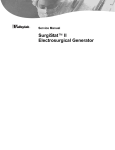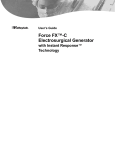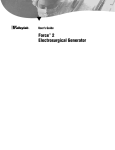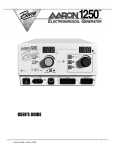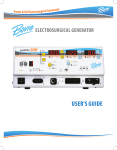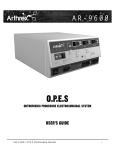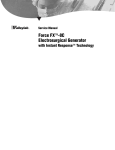Download Surgistat II coagulation Users Manual
Transcript
User’s Guide SurgiStat™ II-20 Electrosurgical Generator This manual and the equipment it describes are for use only by qualified medical professionals trained in the particular technique and surgical procedure to be performed. It is intended as a guide for using the Valleylab SurgiStat™ II-20 electrosurgical generator only. Additional technical information is available in the SurgiStat™ II Electrosurgical Generator Service Manual. Caution Federal (USA) laws restrict this device to sale by or on the order of a physician. Equipment covered in this manual Surg II-20 electrosurgical generator Valleylab Part Number 1003623 Effective Date August 2006 Trademark acknowledgements Valleylab™, ForceTriad™, Force FX™, Force EZ™, Force Argon™, LigaSure™, LigaSmart™, Smart™, Cool-Tip™, TissuFect™, REM™, RFG-3C™, OptiMumm™, SurgiStat™, EDGE™, AccuVac™, PolyHesive™, and Instant Response™ are trademarks of Valleylab. Manufactured for Valleylab a division of Tyco Healthcare Group LP Boulder, Colorado 80301-3299 USA For information call 1-303-530-2300 European representative Tyco Healthcare UK Ltd. Gosport, PO13 0AS, UK Made in USA Printed in USA ©2006 Valleylab All rights reserved. ii SurgiStat II-20 User’s Guide Conventions Used in this Guide Warning Indicates a potentially hazardous situation which, if not avoided, could result in death or serious injury. Caution Indicates a hazardous situation which, if not avoided, may result in minor or moderate injury. Important Indicates an operating tip or maintenance suggestion. Notice Indicates a hazard which may result in product damage. SurgiStat II-20 User’s Guide iii Table of Contents Conventions Used in this Guide List of Figures vii iii Chapter 1. Introducing the SurgiStat II Electrosurgical Generator Key Features 1-2 Components and Accessories Safety 1-3 1-3 Warnings 1-4 Cautions 1-6 Chapter 2. Controls, Indicators, and Receptacles Front Panel 2-2 Cut and Blend Controls 2-3 Coag and Bipolar Controls Indicators 2-4 2-5 Power Switch and Receptacles Rear Panel 2-6 2-7 Symbols on the Front Panel 2-8 Symbols on the Rear Panel 2-9 Chapter 3. Getting Started Initial Inspection Installation 3-2 3-2 Function Checks 3-2 Setting Up the Unit 3-2 Checking the Patient Return Electrode Alarm Confirming Modes 3-3 Checking Bipolar Mode (with Footswitch) 3-3 Checking Monopolar Mode (with Footswitch) Checking Monopolar Mode (with Handswitch) Performance Checks 3-3 3-3 3-4 3-4 Chapter 4. Using the SurgiStat II Inspecting the Generator and Accessories Setup Safety Setting Up 4-2 4-4 Preparing for Monopolar Surgery 4-4 Applying the Patient Return Electrode Connecting Accessories Preparing for Bipolar Surgery Activation Safety Activating the Unit iv 4-2 4-4 4-5 4-5 4-6 4-8 SurgiStat II-20 User’s Guide Chapter 5. Maintaining the SurgiStat II Cleaning 5-2 Periodic Inspection 5-2 Fuse Replacement 5-3 Chapter 6. Troubleshooting General Troubleshooting Guidelines Correcting Malfunctions 6-2 6-2 Chapter 7. Repair Policy and Procedures Responsibility of the Manufacturer 7-2 Returning the Generator for Service 7-2 Obtain a Return Authorization Number Clean the Generator 7-2 7-3 Ship the Generator 7-3 Chapter 8. Technical Specifications Performance Characteristics Input Power Duty Cycle 8-2 8-2 8-2 Dimensions and Weight 8-2 Operating Parameters 8-3 Transport and Storage 8-3 Audio Volume 8-3 Patient Return Electrode Sensing 8-4 Low Frequency (50–60 Hz) Leakage Current High Frequency (RF) Leakage Current Standards and IEC Classifications 8-5 8-5 8-5 Class I Equipment (IEC 60601-1) 8-5 Type CF Equipment (IEC 60601-1)/Defibrillator Proof Liquid Spillage (IEC 60601-2-2 Clause 44.3) Electromagnetic Interference 8-6 8-6 8-6 Voltage Transients (Emergency Generator Mains Transfer) 8-6 Electromagnetic Compatibility (IEC 60601-1-2 and IEC 60601-2-2) Output Characteristics 8-7 Maximum Output for Bipolar and Monopolar Modes Output Power Curves 8-7 8-8 Monopolar Cut Curves Monopolar Coag Curves Bipolar Curves 8-6 8-8 8-11 8-14 Chapter 9. Warranty SurgiStat II-20 User’s Guide v List of Figures Figure 2-1. Layout of controls, indicators, and receptacles on the front panel 2-2 Figure 2-2. Controls for the Cut and Blend modes 2-3 Figure 2-3. Controls for the Desiccate, Fulgurate, and Bipolar modes 2-4 Figure 2-4. Indicators for power, return electrodes, and footswitch control 2-5 Figure 2-5. Location of the unit power switch and front panel receptacles 2-6 Figure 2-6. Layout of connectors and controls on the rear panel 2-7 Figure 8-1. Output power vs. impedance for Pure Cut mode 8-8 Figure 8-2. Peak voltage vs. power setting for Pure Cut mode 8-8 Figure 8-3. Output power vs. generator settings for Pure Cut mode 8-9 Figure 8-4. Output power vs. impedance for Blend mode 8-9 Figure 8-5. Peak voltage vs. power setting for Blend mode 8-10 Figure 8-6. Output power vs. generator settings for Blend mode 8-10 Figure 8-7. Output power vs. impedance for Desiccate mode 8-11 Figure 8-8. Peak voltage vs. power setting for Desiccate mode 8-11 Figure 8-9. Output power vs. generator settings for Desiccate mode 8-12 Figure 8-10. Output power vs. impedance for Fulgurate mode 8-12 Figure 8-11. Peak voltage vs. power setting for Fulgurate mode 8-13 Figure 8-12. Output power vs. generator settings for Fulgurate mode 8-13 Figure 8-13. Output power vs. impedance for Bipolar mode 8-14 Figure 8-14. Peak voltage vs. power setting for Bipolar mode 8-14 Figure 8-15. Output power vs. generator settings for Bipolar mode 8-15 SurgiStat II-20 User’s Guide vii Chapter 1 Introducing the SurgiStat II Electrosurgical Generator 1 This section includes the following information: • Key features • Components and accessories • Safety Caution Read all warnings, cautions, and instructions provided with this generator before using. Read the instructions, warnings, and cautions provided with electrosurgical accessories before using. Specific instructions are not included in this manual. SurgiStat II-20 User’s Guide 1-1 Key Features Key Features The SurgiStat II electrosurgical generator includes the latest technology. This unit offers unsurpassed performance, flexibility, reliability, and convenience. It includes the following features: • Two levels of coagulation: desiccation and fulguration Desiccation provides precise control of bleeding in localized areas. Fulguration provides greater control of bleeding in highly vascular tissue over broad surface areas. Important The RECQMS system requires that you use a split-plate patient return electrode. • Return electrode sensing and contact quality monitoring The SurgiStat II incorporates a return electrode contact quality monitoring system (RECQMS). This system determines the type of patient return electrode: single or split-plate. The system also continually monitors the contact quality between the patient and the split-plate return electrode. This feature is designed to eliminate patient burns at the return electrode site. • Memory The unit automatically powers up to the most recently used modes and power settings. • Power adjustment during activation You can change the power setting while you activate the unit. If you change the power setting for the mode you are using, your change affects the power you are applying to the patient. You can increase or decrease power as much as three watts per second while activating the unit. • Isolated RF output This minimizes the potential of alternate site burns. • Standard connectors These connectors accept the latest monopolar and bipolar instruments. • Self diagnostics These diagnostics continually monitor the unit to ensure proper performance. Valleylab electrosurgical generators, patient return electrodes, and active accessories are designed to work as a system. Valleylab offers a selection of patient return electrodes and electrosurgical instruments that are fully compatible with this generator. When considering other manufacturer’s patient return electrodes and/or active accessories, customers should seek detailed user instructions and warning information from the manufacturer. 1-2 SurgiStat II-20 User’s Guide Components and Accessories You should receive the following components: • SurgiStat II electrosurgical generator • Hospital grade power cord • User’s guide • Service manual The following items are optional accessories that you can use with the SurgiStat II generator: • E6008 – Monopolar footswitch 4.6 m (15 ft) cord • E6008B – Monopolar footswitch 4.6 m (15 ft) cord • E8007 – Compact mounting cart • E8002 – Mounting stand Safety The safe and effective use of electrosurgery depends to a large degree on factors solely under the control of the operator. There is no substitute for a properly trained and vigilant medical staff. It is important that they read, understand, and follow the operating instructions supplied with this electrosurgical equipment. Physicians have used electrosurgical equipment safely in numerous procedures. Before starting any surgical procedure, the surgeon should be familiar with the medical literature, complications, and hazards of using electrosurgery in that procedure. To promote the safe use of the SurgiStat II electrosurgical generator, this section presents the warnings and cautions that appear throughout this user’s guide. So that you can operate this equipment with maximum safety, it is important that you read, understand, and follow the instructions in these warnings and cautions. It is also important that you read, understand, and follow the instructions for use in this user’s guide. SurgiStat II-20 User’s Guide 1-3 Introducing the SurgiStat II Electrosurgical Generator Components and Accessories Safety Warnings Warning Hazardous Electrical Output This equipment is for use only by trained, licensed physicians. Danger: Fire/Explosion Hazard Do not use the SurgiStat II electrosurgical generator in the presence of flammable anesthetics. Fire/Explosion Hazard The following substances will contribute to increased fire and explosion hazards in the operating room: • Flammable substances (such as alcohol based skin prepping agents and tinctures) • Naturally occurring flammable gases that may accumulate in body cavities such as the bowel • Oxygen enriched atmospheres • Oxidizing agents (such as nitrous oxide [N2O] atmospheres) The sparking and heating associated with electrosurgery can provide an ignition source. Observe fire precautions at all times. When using electrosurgery in the same room with any of these substances or gases, prevent their accumulation or pooling under surgical drapes, or within the area where electrosurgery is performed. Electric Shock Hazard Connect the power cord to a properly polarized and grounded power source with the frequency and voltage characteristics that match those listed on the back of the unit. Do not use power plug adapters. Electric Shock Hazard Always turn off and unplug the generator before cleaning. Fire Hazard Do not use extension cords. Patient Safety Use the generator only if the self-test has been completed as described. Otherwise, inaccurate power outputs may result. Failure of the high frequency electrosurgical equipment could result in an unintended increase of output power. The instrument receptacles on this generator are designed to accept only one instrument at a time. Do not attempt to connect more than one instrument at a time into a given receptacle. Doing so will cause simultaneous activation of the instruments. Use the lowest output setting necessary to achieve the desired surgical effect. Use the active electrode only for the minimum time necessary in order to reduce the possibility of unintended burn injury. Pediatric applications and/or procedures performed on small anatomic structures may require reduced power settings. The higher the current flow, and the longer the current is applied, the greater the possibility of unintended thermal damage to tissue, especially during use on small structures. 1-4 SurgiStat II-20 User’s Guide Safety Warning If the patient has an implantable cardioverter defibrillator (ICD), contact the ICD manufacturer for instructions before performing an electrosurgical procedure. Electrosurgery may cause multiple activation of ICDs. Do not use electrosurgical equipment unless properly trained to use it in the specific procedure being undertaken. Use by physicians without such training has resulted in serious, unintended patient injury, including bowel perforation and irreversible tissue necrosis. For surgical procedures where the high frequency current could flow through parts of the body having a relatively small cross-sectional area, the use of bipolar techniques may be desirable to avoid unwanted coagulation. In some circumstances, the potential exists for alternate site burns at points of skin contact (e.g., between the arm and the side of the body). This occurs when electrosurgical current seeks a path to the patient return electrode that includes the skin-to-skin contact point. Current passing through small skin-to-skin contact points is concentrated and may cause a burn. This is true for grounded, ground referenced, and isolated output generators. To reduce the potential for alternate site burns, do one or more of the following: • Avoid skin-to-skin contact points, such as fingers touching leg, when positioning the patient. • Place 5 to 8 cm (2 to 3 in.) of dry gauze between contact points to ensure that contact does not occur. • Position the patient return electrode to provide a direct current route between the surgical site and the return electrode that avoids skin-to-skin contact areas. • In addition, place patient return electrodes according to the manufacturer’s instructions. Potential for alternate site burns increases if the return electrode is compromised. Valleylab recommends the use of split-plate patient return electrodes and Valleylab generators with a contact quality monitoring system. Do not wrap the accessory cords or patient return electrode cords around metal objects. This may induce currents that could lead to shocks, fires, or injury to the patient or surgical team. SurgiStat II-20 User’s Guide 1-5 Introducing the SurgiStat II Electrosurgical Generator Use electrosurgery with caution in the presence of internal or external pacemakers. Interference produced by the use of electrosurgical devices can cause a pacemaker to enter an asynchronous mode or can block the pacemaker effect entirely. Consult the pacemaker manufacturer or hospital Cardiology Department for further information when use of electrosurgical appliances is planned for patients with cardiac pacemakers. Safety Cautions Caution At no time should you touch the active electrode or bipolar forceps. A burn could result. Do not stack equipment on top of the generator or place the generator on top of electrical equipment. These configurations are unstable and/or do not allow adequate cooling. Provide as much distance as possible between the electrosurgical generator and other electronic equipment (such as monitors). An activated electrosurgical generator may cause interference with them. Nonfunction of the generator may cause interruption of surgery. A backup generator should be available for use. Do not turn the activation tone down to an inaudible level. The activation tone alerts the surgical team when an accessory is active. When using a smoke evacuator in conjunction with the electrosurgical generator, place the smoke evacuator at a distance from the generator and set the generator volume control at a level that ensures that the activation tones can be heard. The use of high frequency current can interfere with the function of other electromagnetic equipment. When high frequency surgical equipment and physiological monitoring equipment are used simultaneously on the same patient, place any monitoring electrodes as far as possible from the surgical electrodes. Do not use needles as monitoring electrodes during electrosurgical procedures. Inadvertent electrosurgical burns may result. To avoid the possibility of an electrosurgical burn to either the patient or the physician, do not allow the patient to come in contact with a grounded metal object during activation. When activating the unit, do not allow direct skin contact between the patient and the physician. Remove any loose fitting jewelry from the patient before activation. 1-6 SurgiStat II-20 User’s Guide Safety Caution When not using active accessories, place them in a holster or in a clean, dry, nonconductive, and highly visible area not in contact with the patient. Inadvertent contact with the patient may result in burns. Studies have shown that smoke generated during electrosurgical procedures can be potentially harmful to patients and the surgical team. These studies recommend adequately ventilating the smoke by using a surgical smoke evacuator or other means.1 Notice If required by local codes, connect the generator to the hospital equalization connector with an equipotential cable. Do not clean the generator with abrasive cleaning or disinfectant compounds, solvents, or other materials that could scratch the panels or damage the generator. 1. U.S. Department of Health and Human Services. National Institute for Occupational Safety and Health (NIOSH). Control of Smoke from Laser/Electric Surgical Procedures. HAZARD CONTROLS, Publication No. 96-128, September, 1996. SurgiStat II-20 User’s Guide 1-7 Introducing the SurgiStat II Electrosurgical Generator Examine all accessories and connections to the electrosurgical generator before use. Ensure that the accessories function as intended. Improper connection may result in arcs, sparks, accessory malfunction, or unintended surgical effects. 1-8 SurgiStat II-20 User’s Guide Chapter 2 Controls, Indicators, and Receptacles 2 This section describes the front and rear panels, including all controls, indicators, receptacles, the fuse drawer, and ports. SurgiStat II-20 User’s Guide 2-1 Front Panel Front Panel Figure 2-1. Layout of controls, indicators, and receptacles on the front panel 2-2 SurgiStat II-20 User’s Guide Cut and Blend Controls Cut and Blend Controls Figure 2-2. Controls for the Cut and Blend modes Cut Selector When pressed, selects the Pure Cut mode. Blend Selector When pressed, selects the Blend mode. Blend Indicator Illuminates when Blend mode is selected. SurgiStat II-20 User’s Guide Cut and Blend Power Display (watts) Indicates the power set for the Pure Cut or Blend mode. Cut and Blend Activation Indicator Illuminates when either Pure Cut or Blend mode is activated. Cut and Blend Power Control Dial Increases or decreases the Cut or Blend power output in increments of one watt. 2-3 Controls, Indicators, and Receptacles Cut Indicator Illuminates when Pure Cut mode is selected. Coag and Bipolar Controls Coag and Bipolar Controls Figure 2-3. Controls for the Desiccate, Fulgurate, and Bipolar modes Desiccate Indicator Illuminates when Desiccate mode is selected. Coag and Bipolar Power Display (watts) Indicates the power set for any Coag or Bipolar mode. Coag and Bipolar Activation Indicator Illuminates when Desiccate, Fulgurate, or Bipolar modes are activated. Desiccate Selector When pressed, selects the Desiccate mode. Fulgurate Indicator Illuminates when Fulgurate mode is selected. Fulgurate Selector When pressed, selects the Fulgurate mode. Bipolar Selector When pressed, selects the Bipolar mode. Bipolar Indicator Illuminates when Bipolar mode is selected. 2-4 Coag and Bipolar Power Control Dial Increases or decreases the Coag or Bipolar power output in increments of one watt. SurgiStat II-20 User’s Guide Indicators Indicators Figure 2-4. Indicators for power, return electrodes, and footswitch control Power Indicator Illuminates when the unit is on. Split-Plate Patient Return Electrode Indicator Illuminates when the system detects a split-plate. SurgiStat II-20 User’s Guide Monopolar Footswitch Control Indicator and Symbol Illuminates when monopolar foot control is selected. Single-Plate Patient Return Electrode Indicator Illuminates when the system detects a single-plate. Footswitch Control Selector When pressed, switches between monopolar and bipolar foot control. 2-5 Controls, Indicators, and Receptacles Patient Return Electrode Alarm Indicator Illuminates when the system detects a patient return electrode alarm condition. Bipolar Footswitch Control Indicator and Symbol Illuminates when bipolar foot control is selected. Power Switch and Receptacles Power Switch and Receptacles Figure 2-5. Location of the unit power switch and front panel receptacles Bipolar Receptacle Accepts standard cables for Bipolar handpieces. Power On/Off Switch Turns the unit on or off. Monopolar Handswitching Receptacle Accepts standard three-pin handpieces. Connect handswitching accessories. Patient Return Electrode Receptacle Accepts a standard patient return electrode plug. Monopolar Footswitching Receptacle Accepts cables or adapters equipped with standard (Bovie #12) active plugs. Connect footswitching accessories. 2-6 SurgiStat II-20 User’s Guide Rear Panel Rear Panel Figure 2-6. Layout of connectors and controls on the rear panel Equipotential Connector Allows attaching a standard grounding cable to chassis ground for additional protection against leakage current. Volume Control Controls the volume of the audible tones produced during normal unit activation. To increase volume, rotate the knob clockwise. Controls, Indicators, and Receptacles Footswitch Receptacle Accepts the E6008 or E6008B monopolar footswitch. Use the monopolar footswitch for both monopolar and bipolar activation. Use only a Valleylab monopolar footswitch with the SurgiStat II-20 generator. Use of an incompatible footswitch may cause unexpected output. SurgiStat II-20 User’s Guide Serial Number Label Specifies the unit model number, serial number, nominal line voltage, frequency, current, and power consumption. Power Cable Receptacle and Fuse Holder Connects a hospital grade power cord to supply AC mains power to the unit. 2-7 Symbols on the Front Panel Symbols on the Front Panel Symbols Description Indicators Single-plate patient return electrode Split-plate patient return electrode Monopolar footswitch control Footswitch (on the selector button) Bipolar footswitch control Power Switch and Handpiece Connectors Read instructions before use Type CF equipment F RF isolated – patient connections are isolated from earth at high frequency Caution – high voltage 2-8 SurgiStat II-20 User’s Guide Symbols on the Rear Panel Symbols on the Rear Panel Symbols Description Equipotential ground stud Nonionizing radiation Volume control Controls, Indicators, and Receptacles Danger Explosion risk if used with flammable anesthetics Monopolar footswitch Read instructions before use SurgiStat II-20 User’s Guide 2-9 2-10 SurgiStat II-20 User’s Guide Chapter 3 Getting Started 3 This section includes the following information: • Initial inspection • Installing the unit • Checking unit functions • Testing unit performance SurgiStat II-20 User’s Guide 3-1 Initial Inspection Initial Inspection When you first unpack your SurgiStat II generator, inspect it visually: • Look for any signs of damage. • Verify that the shipping package contains all items listed on the packing list. If the unit or any accessories are damaged, notify Valleylab Customer Service immediately. Do not use any damaged equipment. Installation Place the SurgiStat II on any flat surface with a tilt angle not more than 10°. The unit relies on natural convection cooling. Do not block its bottom or rear vents. Ensure that air flows freely on all sides of the unit. Warning Connect the power cord to a properly polarized and grounded power source with the frequency and voltage characteristics that match those listed on the back of the unit. Function Checks Upon initial installation of the unit, perform the following checks. Refer to the figures in the previous chapter for the location of connectors and controls. Caution At no time should you touch the active electrode or bipolar forceps. A burn could result. Setting Up the Unit 1. Verify that the Power Switch is in the Off (O) position and that no accessories are connected to the unit. 2. Connect a hospital grade power cable to the AC power cable receptacle on the back of the unit, then to a properly grounded wall outlet. 3. Connect a two-pedal footswitch to the appropriate footswitch receptacle on the back of the unit. Use only a Valleylab footswitch with the SurgiStat II-20 generator. Although other types of footswitches may fit, they may not be compatible. Use of an incompatible footswitch may cause unexpected output. 3-2 SurgiStat II-20 User’s Guide Function Checks 4. Do not connect a patient return electrode at this time. 5. Turn the unit on by switching the power switch to the On (|) position. Checking the Patient Return Electrode Alarm 1. Adjust the power settings for each mode (Cut, Blend, Desiccate, Fulgurate, and Bipolar) to one watt. 2. Press the Cut pedal of the footswitch. 3. Verify that an alarm sounds for three seconds and the Patient Return Electrode Sensing Alarm Indicator Light illuminates, indicating that you have not connected a patient return electrode to the unit. 4. Verify that adjusting the volume control on the back of the unit while the alarm is sounding cannot change the alarm sound level. Confirming Modes Confirm that you can select each mode and adjust power up and down. Checking Bipolar Mode (with Footswitch) 1. Select Bipolar mode by pressing the Bipolar Mode Selector. Note: The unit automatically changes to bipolar footswitching when the bipolar mode is selected. 2. Verify that the Bipolar Mode Indicator illuminates and that the system generates the Coag tone when you press the Coag pedal (Blue) or the Cut pedal (Yellow) on the footswitch. range to verify that the sound is audible throughout the range. 4. Confirm that releasing the Coag pedal or the Cut pedal returns the unit to an idle state. Checking Monopolar Mode (with Footswitch) 1. Select monopolar foot control by pressing the Footswitch Control Selector until the Monopolar Footswitch Control Indicator illuminates. 2. Connect a single-plate patient return electrode to the Return Electrode receptacle of the unit. Verify that the green single-plate patient return electrode indicator illuminates. 3. Press the Cut pedal on the footswitch. Verify that the Cut and Blend Activation Indicator illuminates and that the system generates the Cut activation tone. 4. While activating the Cut mode, rotate the volume control over the full range to verify that the sound is audible throughout the range. SurgiStat II-20 User’s Guide 3-3 Getting Started 3. While activating the Bipolar mode, rotate the volume control over the full Performance Checks 5. Press the Coag pedal on the footswitch. Verify that the Desiccate, Fulgurate, and Bipolar Activation Indicator illuminates and that the system generates the Coag activation tone. 6. While activating the Coag mode, rotate the volume control over the full range to verify that the sound is audible throughout the range. Checking Monopolar Mode (with Handswitch) 1. Connect a handswitching handpiece to the Monopolar Handswitching receptacle. 2. Activate, one at a time, the Cut and Coag handswitching controls. 3. Verify that each control causes the correct indicator to illuminate and tone to sound. Performance Checks After the unit has passed the preliminary functional test, it is ready for performance testing. A qualified biomedical engineer who is thoroughly familiar with electrosurgical devices should conduct this testing. The testing should include checking all modes of operation for proper function and power output. For a detailed description of performance testing procedures, refer to the SurgiStat II Electrosurgical Generator Service Manual. 3-4 SurgiStat II-20 User’s Guide Chapter 4 Using the SurgiStat II 4 This section contains the following procedures: • Inspecting the generator and accessories • Setup safety • Setting up • Preparing for monopolar surgery • Preparing for bipolar surgery • Activation safety • Activating the unit Caution Read all warnings, cautions, and instructions provided with this generator before use. Read the instructions, warnings, and cautions provided with electrosurgical accessories before use. Specific instructions are not included in this manual. SurgiStat II-20 User’s Guide 4-1 Inspecting the Generator and Accessories Inspecting the Generator and Accessories Before each use of the SurgiStat II, verify that the unit and all accessories are in good working order: • Inspect for damage to the generator and all its connections. • Verify that the appropriate accessories and adapters are present. • Inspect all cords and connectors for signs of wear, damage, and abrasion. • Verify that no errors occur when you turn on the unit. Setup Safety Warning Hazardous Electrical Output This equipment is for use only by trained, licensed physicians. Electric Shock Hazard Connect the generator power cord to a properly grounded receptacle. Do not use power plug adapters. Connect the power cord to a properly polarized and grounded power source with the frequency and voltage characteristics that match those listed on the back of the unit. Fire Hazard Do not use extension cords. Patient Safety Use the generator only if the self-test has been completed as described. Otherwise, inaccurate power outputs may result. The instrument receptacles on this generator are designed to accept only one instrument at a time. Do not attempt to connect more than one instrument at a time into a given receptacle. Doing so will cause simultaneous activation of the instruments. Failure of the high frequency electrosurgical equipment could result in an unintended increase of output power. Do not use electrosurgical equipment unless properly trained to use it in the specific procedure being undertaken. Use by physicians without such training has resulted in serious, unintended patient injury, including bowel perforation and irreversible tissue necrosis. For surgical procedures where the high frequency current could flow through parts of the body having a relatively small cross-sectional area, the use of bipolar techniques may be desirable to avoid unwanted coagulation. If the patient has an implantable cardioverter defibrillator (ICD), contact the ICD manufacturer for instructions before performing an electrosurgical procedure. Electrosurgery may cause multiple activation of ICDs. 4-2 SurgiStat II-20 User’s Guide Setup Safety Warning In some circumstances, the potential exists for alternate site burns at points of skin contact (e.g., between the arm and the side of the body). This occurs when electrosurgical current seeks a path to the patient return electrode that includes the skin-to-skin contact point. Current passing through small skin-to-skin contact points is concentrated and may cause a burn. This is true for grounded, ground referenced, and isolated output generators. To reduce the potential for alternate site burns, do one or more of the following: • Avoid skin-to-skin contact points, such as fingers touching leg, when positioning the patient. • Place 5 to 8 cm (2 to 3 in.) of dry gauze between contact points to ensure that contact does not occur. • Position the patient return electrode to provide a direct current route between the surgical site and the return electrode that avoids skin-to-skin contact areas. • In addition, place patient return electrodes according to the manufacturer’s instructions. Potential for alternate site burns increases if the return electrode is compromised. Valleylab recommends the use of split-plate patient return electrodes and Valleylab generators with a contact quality monitoring system. Caution Do not stack equipment on top of the generator or place the generator on top of electrical equipment. These configurations are unstable and/or do not allow adequate cooling. Provide as much distance as possible between the electrosurgical generator and other electronic equipment (such as monitors). An activated electrosurgical generator may cause interference with them. Nonfunction of the generator may cause interruption of surgery. A backup generator should be available for use. Do not turn the activation tone down to an inaudible level. The activation tone alerts the surgical team when an accessory is active. When using a smoke evacuator in conjunction with the electrosurgical generator, place the smoke evacuator a distance from the generator and set the generator volume control at a level that ensures that the activation tones can be heard. Notice If required by local codes, connect the generator to the hospital equalization connector with an equipotential cable. Using the SurgiStat II Connect the power cord to a wall outlet having the correct voltage. Otherwise product damage may result. SurgiStat II-20 User’s Guide 4-3 Setting Up Setting Up 1. Verify that the generator is off by pressing the power switch Off (O). 2. Place the generator on a stable flat surface, such as a table, platform, or Valleylab cart. Carts with conductive wheels are recommended. For details, refer to the procedures for your institution or to local codes. Provide at least 10 to 15 cm (4 to 6 in.) of space from the sides and top of the generator for cooling. Normally, the top, sides, and rear panel are warm when you use the generator continuously for extended periods of time. 3. Plug the generator power cord into the AC Power Cable Receptacle on the rear panel. 4. Plug the generator power cord into a grounded receptacle. 5. Turn on the generator by pressing the power switch On (|). Verify the following: • All visual indicators and displays on the front panel illuminate. • Activation tones sound to verify that the speaker is working properly. 6. If the self-test is successful, a tone sounds. Verify the following: • A Cut mode is selected, and a Coag or Bipolar mode is selected. • Each display shows a power setting. The unit automatically powers up to the most recently used power settings. • The Patient Return Electrode Alarm Indicator illuminates red. If the self-test is not successful, an alarm tone sounds. A number may momentarily appear in the Cut display and, in most cases, the generator is disabled. Note the number and refer to Troubleshooting, Section 6. Once the self-test is successful, connect the accessories and set the generator controls. Refer to Preparing for Monopolar Surgery or Preparing for Bipolar Surgery later in this section. Preparing for Monopolar Surgery Applying the Patient Return Electrode Monopolar surgery requires a patient return electrode. Valleylab recommends using return electrode contact quality monitoring system (RECQMS) patient return electrodes to maximize patient safety. The REM system is designed to minimize the risk of burns at the return electrode site due to a reduction in patient contact area during monopolar electrosurgery. Using a patient return electrode without the RECQMS safety feature may result in a patient burn. 4-4 SurgiStat II-20 User’s Guide Preparing for Bipolar Surgery 1. Apply the patient return electrode to the patient. Refer to the manufacturer’s instructions for application site and placement procedures. When using metal plate patient return electrodes, use a conductive gel specifically designed for electrosurgery. Select a patient return electrode site with good blood flow. While a properly applied electrode results in minimal tissue heating beneath the electrode, a good blood flow helps carry heat away from the site. Important The RECQMS system requires that you use a split-plate patient return electrode. 2. Connect the cable to the Patient Return Electrode Receptacle on the front of the unit. 3. After a delay of approximately three seconds, the unit will sense the presence of a single or split-plate patient return electrode. The unit will then constantly monitor the resistance of the single-plate electrode or the resistance at the contact between the split-plate electrode and the patient. Connecting Accessories 1. Connect a monopolar active electrode to the unit: If you are using ... Connect it to ... Standard 3-pin handswitching pencil Monopolar Handswitching Receptacle Footswitching pencil Monopolar Footswitching Receptacle 2. If using a footswitch activated device, connect an appropriate Valleylab footswitch to the Footswitch Connecting Socket on the rear of the unit. Use only a Valleylab footswitch with the SurgiStat II-20 generator. Use of an incompatible footswitch may cause unexpected output. Preparing for Bipolar Surgery 1. Select the Bipolar Mode by pressing the Bipolar Mode Selector. The Bipolar Mode Indicator will illuminate. Note: The unit automatically changes to Bipolar Footswitching mode when you select Bipolar mode. 2. Connect a Bipolar cable to the Bipolar Receptacle. 3. Connect the appropriate Valleylab Footswitch to the Footswitch Receptacle on Using the SurgiStat II the rear of the unit. 4. Connect a forceps instrument to the Bipolar cable. SurgiStat II-20 User’s Guide 4-5 Activation Safety Activation Safety . Warning Do not wrap the accessory cords or patient return electrode cords around metal objects. This may induce currents that could lead to shocks, fires, or injury to the patient or surgical team. Danger: Fire/Explosion Hazard Do not use the SurgiStat II electrosurgical generator in the presence of flammable anesthetics. Fire/Explosion Hazard The following substances will contribute to increased fire and explosion hazards in the operating room: • Flammable substances (such as alcohol based skin prepping agents and tinctures) • Naturally occurring flammable gases that may accumulate in body cavities such as the bowel • Oxygen enriched atmospheres • Oxidizing agents (such as nitrous oxide [N2O] atmospheres) The sparking and heating associated with electrosurgery can provide an ignition source. Observe fire precautions at all times. When using electrosurgery in the same room with any of these substances or gases, prevent their accumulation or pooling under surgical drapes, or within the area where electrosurgery is performed. Use the lowest output setting necessary to achieve the desired surgical effect. Use the active electrode only for the minimum time necessary in order to lessen the possibility of unintended burn injury. Pediatric applications and/or procedures performed on small anatomic structures may require reduced power settings. The higher the current flow, and the longer the current is applied, the greater the possibility of unintended thermal damage to tissue, especially during use on small structures. Use electrosurgery with caution in the presence of internal or external pacemakers. Interference produced by the use of electrosurgical devices can cause a pacemaker to enter an asynchronous mode or can block the pacemaker effect entirely. Consult the pacemaker manufacturer or hospital Cardiology Department for further information when use of electrosurgical appliances is planned for patients with cardiac pacemakers. 4-6 SurgiStat II-20 User’s Guide Activation Safety Caution The use of high frequency current can interfere with the function of other electromagnetic equipment. When high frequency surgical equipment and physiological monitoring equipment are used simultaneously on the same patient, place any monitoring electrodes as far as possible from the surgical electrodes. Do not use needles as monitoring electrodes during electrosurgical procedures. Inadvertent electrosurgical burns may result. To avoid the possibility of an electrosurgical burn to either the patient or the physician, do not allow the patient to come in contact with a grounded metal object during activation. When activating the unit, do not allow direct skin contact between the patient and the physician. Remove any loose fitting jewelry from the patient before activation. Studies have shown that smoke generated during electrosurgical procedures can be potentially harmful to patients and the surgical team. These studies recommend adequately ventilating the smoke by using a surgical smoke evacuator or other means.1 Examine all accessories and connections to the electrosurgical generator before use. Ensure that the accessories function as intended. Improper connection may result in arcs, sparks, accessory malfunction, or unintended surgical effects. When not using active accessories, place them in a holster or in a clean, dry, nonconductive, and highly visible area not in contact with the patient. Inadvertent contact with the patient may result in burns. 1. U.S. Department of Health and Human Services. National Institute for Occupational Safety and Health (NIOSH). Control of Smoke from Laser/Electric Surgical Procedures. HAZARD CONTROLS, Publication No. 96-128, September, 1996. Using the SurgiStat II SurgiStat II-20 User’s Guide 4-7 Activating the Unit Activating the Unit During a surgical procedure, the amount of current delivered during a given time period determines the amount of heating that occurs under the electrode. All Valleylab patient return electrodes are designed for use during traditional surgical procedures and duty cycles (on time compared to off time). Users should consult the Technical Specifications section of the generator user manual for the recommended maximum duty cycle specifications. It is not possible to foresee what combination of current and duty cycle may be safely used in every situation, such as when higher currents and/or longer duty cycles are used on procedures such as tissue lesioning, tissue ablation, tissue vaporization, and procedures where conductive fluid is introduced into the surgical site. Under these conditions there can be greater risk that the heating under a fully applied return electrode may be high enough to injure the patient. When using a Valleylab generator or patient return electrode during these types of surgical procedures the user should seek written guidance from the manufacturer of the active accessory regarding the currents and duty cycles that can be expected as well as detailed user instructions. In some instances, the application of additional patient return electrodes may help mitigate the increased risk. When you turn on your unit, remember these features: • SurgiStat II will power up to the most recently used modes and most recently used settings. For example, if you set Pure Cut mode at 50 watts when you turned the unit off, it will automatically return to Pure Cut mode at 50 watts when you turn it on again. Similarly, if you set Desiccate mode at 40 watts before you turned the unit off, it will return to Desiccate mode at 40 watts when you turn it on again. • When you switch from Pure Cut mode to Blend (or the reverse), the unit maintains its power setting. Also, when you switch among Desiccate, Fulgurate, and Bipolar, the unit maintains its power setting. For example, if you are working in Pure Cut at 75 watts and you switch to Blend, the unit maintains a power setting of 75 watts. EXCEPTION: If you are working in Pure Cut mode at 110 watts and switch to Blend mode, the unit automatically reduces its power setting to the maximum setting for Blend mode, 90 watts. Similarly, if you are working in Desiccate mode at 25 watts and switch to Fulgurate or Bipolar, the unit maintains 25 watts. EXCEPTION: If you are working in Desiccate mode at a power setting of 80 watts and switch to Fulgurate mode, the unit automatically reduces its power setting to the maximum for Fulgurate, 40 watts. If you switch to Bipolar, the unit automatically reduces its power setting to the maximum for Bipolar, 30 watts. 4-8 SurgiStat II-20 User’s Guide Activating the Unit • You can change the power setting while you activate the unit. If you change the power setting for the mode you are using, your change affects the power you are applying to the patient. You can increase or decrease power as much as three watts per second while activating the unit. For example, if you have activated Pure Cut at 50 watts, you can increase the Pure Cut power to 60 watts while continuing to activate the unit. The power output increases from 50 to 60 watts. At the same time, you can increase the power setting of the mode that is not currently active. For example, if you have activated Blend mode at 50 watts, you can increase the power setting in the Desiccate mode from 30 to 40 watts. The setting for Desiccate increases to 40 watts, but the Blend power output remains at 50 watts. 1. Monopolar Cut: Select the desired Cut power settings by rotating the Cut and Blend Power Control Dial. 2. Monopolar Coag: Select the mode of operation for coagulation: Desiccate or Fulgurate, then select the coagulation power settings by rotating the Desiccate, Fulgurate, and Bipolar Power Control Dial. 3. Bipolar: Select the mode of operation for Bipolar, then select the Bipolar power settings by rotating the Desiccation, Fulguration, and Bipolar Power Control Dial. 4. Activate the generator by pressing the appropriate button: Important One footswitch activates either monopolar or bipolar footswitching accessories. To activate... press this... on this device... Monopolar Cut or Blend modes yellow button yellow pedal handswitching pencil footswitch Desiccate or Fulgurate modes blue button blue pedal handswitching pencil footswitch yellow (Cut) or blue (Coag) pedal footswitch Bipolar Any Bipolar Using the SurgiStat II SurgiStat II-20 User’s Guide 4-9 4-10 SurgiStat II-20 User’s Guide Chapter 5 Maintaining the SurgiStat II 5 This section covers the following topics: • Cleaning • Periodic inspection • Fuse replacement SurgiStat II-20 User’s Guide 5-1 Cleaning Valleylab recommends that you complete periodic inspection and performance testing. Perform inspections and performance testing every six months. A qualified biomedical technician should conduct this testing to ensure that the unit is operating effectively and safely. Cleaning After each use, clean the unit. Warning Electric Shock Hazard Always turn off and unplug the generator before cleaning. Caution Do not allow fluids to enter the generator chassis. Do not sterilize the generator. Notice Do not clean the generator with abrasive cleaning or disinfectant compounds, solvents, or other materials that could scratch the panels or damage the generator. 1. Turn off the generator, and unplug the power cord from the wall outlet. 2. Thoroughly wipe all surfaces of the generator and power cord with a mild cleaning solution or disinfectant and a damp cloth. Follow the procedures approved by your institution or use a validated infection control procedure. Periodic Inspection Every six months, visually inspect the SurgiStat II for signs of wear or damage. In particular, look for any of the following problems: 5-2 • Damage to the power cord • Damage to the power cable receptacle • Obvious damage to the unit • Damage to any receptacle • Accumulation of lint or debris in or around the unit SurgiStat II-20 User’s Guide Fuse Replacement Fuses for the unit reside directly below the Power Cable Receptacle on the rear of the unit. To replace the fuses, follow this procedure: 1. Unplug the power cord from the wall outlet. 2. Remove the power cord from the Power Cable Receptacle on the rear panel. 3. To release the fuse drawer, insert a small flathead screwdriver into the slot on the drawer below the power cord receptacle and slide the drawer out. 4. Remove the two fuses and Fuse Drawer replace them with new fuses with the same values. 5. Insert the fuse drawer into the Power Cable Receptacle. Use the following fuses: Surg II-20 110–120 V SurgiStat II-20 User’s Guide VAC 250 Amps 5.0 A Type Slow Blow Size 5 x 20 mm 5-3 Maintaining the SurgiStat II Fuse Replacement 5-4 SurgiStat II-20 User’s Guide Chapter 6 Troubleshooting 6 This section includes error code descriptions and actions to take to resolve them. SurgiStat II-20 User’s Guide 6-1 General Troubleshooting Guidelines General Troubleshooting Guidelines The SurgiStat II includes automatic self-diagnostics. If the diagnostics detect an error, the system displays an error code, sounds an audible tone, and deactivates the unit output power. Correcting Malfunctions Most error codes result from faults in accessories attached to the unit. The following table lists the error codes, describes the error, and recommends actions to take to resolve the error. Error Code F1 (on the Cut/Blend Display) F1 (on the Desiccate/ Fulgurate/ Bipolar display) Description Recommended Action Handswitch or monopolar footswitch cut pedal may be stuck 1. Turn off, then turn on the generator. Do not press buttons or accessory activation devices during the selftest. Handswitch or monopolar footswitch coag pedal may be stuck 2. If the alarm number reappears, disconnect all accessories. Turn off, then turn on the generator again. 3. If the problem persists, replace the handpiece or footswitch and repeat Step 1. 4. If the alarm number reappears, record the number and call the Valleylab Service Center. 6-2 F2 Cut and Coag buttons activated simultaneously (pencil or footswitch) The unit does not allow simultaneous activation of the cut and coagulation modes. Release either the cut or coag button on the handpiece, or the cut or coag pedal on the footswitch. F3 Monopolar handpiece activated while in Bipolar mode Release pressure on the handpiece buttons. Use the footswitch to activate Bipolar, or switch to Monopolar mode. E4 Line voltage error (Line voltage too high) 1. Turn the unit off. 2. Verify that the unit is connected to the correct line voltage. SurgiStat II-20 User’s Guide Correcting Malfunctions Error Code E5 Description Recommended Action Internal pulse width measurement exceeds setting requirements 1. Turn unit off. 2. If using a metal patient return electrode plate, verify that the cable connections are secure and replace cables with loose connections. Turn unit on. 3. If error code occurred directly after changing mode of operation, turn on the unit and delay activation of the accessories after changing mode of operation. 4. If alarm number reappears upon restarting the unit, record the number and call the Valleylab Service Center. E6 Internal pulse width measurement conflicts with calibrated value 1. Turn unit off. 3. If error code occurred directly after changing the power setting during activation, turn on the unit and limit the change of power to approximately three watts per second. 4. If alarm number reappears upon restarting the unit, record the number and call the Valleylab Service Center. E7 Internal temperature of the unit exceeded limit 1. Turn the unit off. 2. Allow the unit to cool for 20 minutes. If the unit displays any other error code, it requires service. SurgiStat II-20 User’s Guide 6-3 Troubleshooting 2. If error code occurred directly after changing mode of operation, turn on the unit and delay activation of the accessories after changing mode of operation. 6-4 SurgiStat II-20 User’s Guide Chapter 7 Repair Policy and Procedures 7 Refer to this section for information on • The manufacturer’s responsibility • Returning the generator for service • Returning circuit boards • Finding service centers SurgiStat II-20 User’s Guide 7-1 Responsibility of the Manufacturer Responsibility of the Manufacturer Valleylab is responsible for the safety, reliability, and performance of the generator only under the following circumstances: • The user has followed the installation and setup procedures in this manual. • Persons authorized by Valleylab performed assembly operation, readjustments, modifications, or repairs. • The electrical installation of the relevant room complies with local codes and regulatory requirements, such as IEC and BSI. • Equipment use is in accordance with the Valleylab instructions for use. For warranty information, refer to Chapter 9, Warranty. Returning the Generator for Service Before you return the generator, call your Valleylab representative for assistance. If instructed to send the generator to Valleylab, first obtain a Return Authorization Number. Then, clean the generator and ship it to Valleylab for service. Step 1 – Obtain a Return Authorization Number Call the Valleylab Customer Service Center for your area to obtain a Return Authorization Number. Have the following information ready when you call: 7-2 • Hospital/clinic name/customer number • Telephone number • Department/address, city, state, and zip code • Model number • Serial number • Description of the problem • Type of repair to be done SurgiStat II-20 User’s Guide Returning the Generator for Service Step 2 – Clean the Generator Warning Electric Shock Hazard Always turn off and unplug the generator before cleaning. Caution Do not allow fluids to enter the generator chassis. Do not sterilize the generator. Notice Do not clean the generator with abrasive cleaning or disinfectant compounds, solvents, or other materials that could scratch the panels or damage the generator. A. Turn off the generator, and unplug the power cord from the wall outlet. B. Thoroughly wipe all surfaces of the generator and power cord with a mild cleaning solution or disinfectant and a damp cloth. Follow the procedures approved by your institution or use a validated infection control procedure. Step 3 – Ship the Generator A. Attach a tag to the generator that includes the Return Authorization Number B. Be sure the generator is completely dry before you pack it for shipment. Package it in its original shipping container. If the original shipping container is not available, request one when obtaining your Return Authorization Number. C. Ship the generator, prepaid, to the Valleylab Service Center. Service Center For a complete list of service centers worldwide, please refer to the Valleylab website: http://www.valleylab.com/valleylab/international/service-world.html SurgiStat II-20 User’s Guide 7-3 Repair Policy and Procedures and the information (hospital, phone number, etc.) listed in Step 1 – Obtain a Return Authorization Number. 7-4 SurgiStat II-20 User’s Guide Chapter 8 Technical Specifications 8 All specifications are nominal and subject to change without notice. A specification referred to as “typical” is within ± 20% of a stated value at room temperature (25° C / 77° F) and a nominal input power voltage. SurgiStat II-20 User’s Guide 8-1 Performance Characteristics Performance Characteristics Input Power 110–120 Volt Nominal input power voltage for calibration: 120 V Mains line frequency range (nominal): 50–60 Hz Power consumption: 360 VA Fuses (2): 5A (Slow Blow) Duty Cycle Under maximum power settings and rated load conditions (Pure Cut, 120 watt @ 500 Ω load), the generator is suitable for activation times of 10 seconds on, 30 seconds off for one hour. Dimensions and Weight 8-2 Width 26 cm (10.25 in.) Depth 30.5 cm (12 in.) Height 15.2 cm (6 in.) Weight < 6.5 kg (< 14 lbs) SurgiStat II-20 User’s Guide Performance Characteristics Operating Parameters Ambient temperature range 10° to 40° C (50° to 104° F) Relative humidity 15% to 75%, noncondensing Atmospheric pressure 700 to 1060 millibars Warm-up time If transported or stored at temperatures outside the operating temperature range, allow one hour for the generator to reach room temperature before use. Transport and Storage Ambient temperature range -34° to 65° C (-29° to 149° F) Relative humidity 0% to 75%, noncondensing Atmospheric pressure 500 to 1060 millibars Audio Volume The audio levels stated below are for activation tones (Bipolar, Cut, and Coag) and alarm tones (return electrode and system alarms) at a distance of one meter. Alarm tones meet the requirements for IEC 60601-2-2. Activation Tone Volume (adjustable) 45 to 65 dBA Frequency Cut: 1 kHz Blend: 1 kHz Technical Specifications Desiccation: 2 kHz Fulguration: 2 kHz Bipolar: 2 kHz Duration SurgiStat II-20 User’s Guide Continuous while the generator is activated 8-3 Performance Characteristics Alarm Tone Volume (not adjustable) 70 dBA ± 5 dBA Frequency 2 kHz for 1 second, then 1 kHz for 1 second Duration 4 seconds Patient Return Electrode Sensing Single-Plate Measurement current: <100 µA Measurement frequency: 62.5 kHz ± 2.5 kHz Set resistance: 0 Ω to 5 Ω ± 3 Ω Continuous measurement: Once the system establishes the single-plate electrode resistance, an increase of 20 Ω ± 5 Ω in resistance will cause an alarm. When the alarm condition exists, the system deactivates output power. Split-Plate Measurement current: <100 µA Measurement frequency: 62.5 kHz ± 2.5 kHz Set resistance: 10 Ω ± 5 Ω to 135 Ω ± 10 Ω Continuous measurement: Once the system establishes the split-plate electrode resistance, an increase of 40% in resistance or up to 150 Ω (whichever is less) will cause an alarm. A decrease of resistance below 4 Ω ± 2 Ω will cause an alarm. When the alarm condition exists, the system deactivates output power. The system presents audible and visible alarms when it does not sense a patient return electrode. 8-4 • When a fault condition occurs, the alarm indicator flashes red, an alarm tone sounds, and the system disables output power. • The red LED alarm indicator remains illuminated until the condition that caused the alarm is corrected. • Activation attempts during an alarm condition result in an audio alarm and the alarm indicator flashes. SurgiStat II-20 User’s Guide Standards and IEC Classifications • When the alarm condition is resolved, the green single or split-plate indicator will illuminate. • The system measures the return electrode sensing current according to IEC 60601-1. Low Frequency (50–60 Hz) Leakage Current Enclosure source current, ground open < 300 µA Source current, patient leads, all outputs Normal polarity, intact ground: < 10 µA Normal polarity, ground open: < 50 µA Reverse polarity, ground open: < 50 µA Sink current at high line, all inputs < 50 µA High Frequency (RF) Leakage Current Bipolar RF leakage current < 39 mA rms Monopolar RF leakage current (additional tolerance) < 150 mA rms Standards and IEC Classifications The SurgiStat II-20 generator meets all pertinent clauses of the IEC 60601-1 second edition and IEC 60601-2-2 third edition. Class I Equipment (IEC 60601-1) SurgiStat II-20 User’s Guide 8-5 Technical Specifications Accessible conductive parts cannot become live in the event of a basic insulation failure because of the way in which they are connected to the protective earth conductor. Standards and IEC Classifications Type CF Equipment (IEC 60601-1)/Defibrillator Proof The SurgiStat II generator provides a high degree of protection against electric shock, particularly regarding allowable leakage currents. It is type CF isolated (floating) output and may be used for procedures involving the heart. Liquid Spillage (IEC 60601-2-2 Clause 44.3) The SurgiStat II-20 generator enclosure is constructed so that liquid spillage in normal use does not wet electrical insulation or other components which, when wetted, are likely to adversely affect the safety of the equipment. Electromagnetic Interference When placed on or beneath an activated Valleylab electrosurgical generator, the SurgiStat II generator operates without interference. The generator minimizes electromagnetic interference to video equipment used in the operating room. Voltage Transients (Emergency Generator Mains Transfer) The SurgiStat II generator operates in a safe manner when the transfer is made between line AC and an emergency generator voltage source. Electromagnetic Compatibility (IEC 60601-1-2 and IEC 60601-2-2) The SurgiStat II generator complies with the appropriate IEC 60601-1-2 and IEC 60601-2-2 specifications regarding electromagnetic compatibility. Notice The SurgiStat II requires special precautions regarding EMC and needs to be installed and put into service according to the EMC information provided in the SurgiStat II Service Manual. Portable and mobile RF communications equipment can affect the SurgiStat II. Refer to the EMC information provided in the SurgiStat II Service Manual. 8-6 SurgiStat II-20 User’s Guide Output Characteristics Output Characteristics Maximum Output for Bipolar and Monopolar Modes Power readouts agree with actual power into rated load to within 20% or 5 watts, whichever is greater. All measurements were taken at the nominal input power voltage used for calibration. Output Power Output Frequency Repetition Rate Vp-p max Crest Factor* (Rated Load) Cut 120 W @ 500 Ω 357 kHz ± 50 kHz N/A 2.5 kV 2.9 ± 20% Blend 90 W @ 800 Ω 357 kHz ± 50 kHz 30 kHz ± 5 kHz 3.5 kV 3.3 ± 20% Desiccate 80 W @ 1000 Ω 475 kHz ± 50 kHz 57 kHz ± 5 kHz 4.5 kV 5.5 ± 20% Fulgurate 40 W @ 1000 Ω 410 kHz ± 50 kHz 25 kHz ± 5 kHz 6.5 kV 7.7 ± 20% Bipolar 30 W @ 200 Ω 520 kHz ± 50 kHz 32 kHz ± 5 kHz 2.0 kV 6.9 ± 20% Mode * An indication of a waveform’s ability to coagulate bleeders without a cutting effect Technical Specifications SurgiStat II-20 User’s Guide 8-7 Output Power Curves Output Power Curves The curves that follow depict the changes for each mode at specific power settings. All measurements were taken at the nominal input power voltage used for calibration. Monopolar Cut Curves These measurements were taken using short (< 0.5 meter) leads. For each output power vs. impedance curve, the upper curve represents readings taken at full power; the lower curve, readings taken at half power. Output Power (watts) Figure 8-1 . Output power vs. impedance for Pure Cut mode Load Resistance (ohms) Open Circuit Peak Voltage (volts) Figure 8-2. Peak voltage vs. power setting for Pure Cut mode Output Power Setting (watts) 8-8 SurgiStat II-20 User’s Guide Output Power Curves Figure 8-3. Output power vs. generator settings for Pure Cut mode 130 120 110 Output Power (watts) 100 90 80 70 60 50 40 30 20 10 0 0 5 10 15 20 25 30 35 40 45 50 55 60 65 70 75 80 85 90 95 100 105 110 115 120 Generator Setting Output Power (watts) Figure 8-4. Output power vs. impedance for Blend mode Load Resistance (ohms) Technical Specifications SurgiStat II-20 User’s Guide 8-9 Figure 8-5. Peak voltage vs. power setting for Blend mode Open Circuit Peak Voltage (volts) Output Power Curves Output Power Setting (watts) Figure 8-6. Output power vs. generator settings for Blend mode 100 90 Output Power (watts) 80 70 60 50 40 30 20 10 0 0 5 10 15 20 25 30 35 40 45 50 55 60 65 70 75 80 85 90 Generator Setting 8-10 SurgiStat II-20 User’s Guide Output Power Curves Monopolar Coag Curves These measurements were taken using short (< 0.5 meter) leads. Output Power (watts) Figure 8-7. Output power vs. impedance for Desiccate mode Load Resistance (ohms) Open Circuit Peak Voltage (volts) Figure 8-8. Peak voltage vs. power setting for Desiccate mode Output Power Setting (watts) Technical Specifications SurgiStat II-20 User’s Guide 8-11 Output Power Curves Figure 8-9. Output power vs. generator settings for Desiccate mode 80 70 Output Power (watts) 60 50 40 30 20 10 0 0 5 10 15 20 25 30 35 40 45 50 55 60 65 70 75 80 Generator Setting Output Power (watts) Figure 8-10. Output power vs. impedance for Fulgurate mode Load Resistance (ohms) 8-12 SurgiStat II-20 User’s Guide Figure 8-11. Peak voltage vs. power setting for Fulgurate mode Open Circuit Peak Voltage (volts) Output Power Curves Output Power Setting (watts) Figure 8-12. Output power vs. generator settings for Fulgurate mode 40 35 Output Power (watts) 30 25 20 15 10 5 0 0 5 10 15 20 25 30 35 40 Generator Setting Technical Specifications SurgiStat II-20 User’s Guide 8-13 Output Power Curves Bipolar Curves Output Power (watts) Figure 8-13. Output power vs. impedance for Bipolar mode Load Resistance (ohms) Open Circuit Peak Voltage (volts) Figure 8-14. Peak voltage vs. power setting for Bipolar mode 8-14 Output Power Setting (watts) SurgiStat II-20 User’s Guide Output Power Curves Figure 8-15. Output power vs. generator settings for Bipolar mode 30 Output Power (watts) 25 20 15 10 5 0 0 5 10 15 20 25 30 Generator Setting Technical Specifications SurgiStat II-20 User’s Guide 8-15 8-16 SurgiStat II-20 User’s Guide Chapter 9 Warranty 9 Valleylab, a division of Tyco Healthcare Group LP, warrants each product manufactured by it to be free from defects in material and workmanship under normal use and service for the period(s) set forth below. Valleylab’s obligation under this warranty is limited to the repair or replacement, at its sole option, of any product, or part thereof, which has been returned to it or its Distributor within the applicable time period shown below after delivery of the product to the original purchaser, and which examination discloses, to Valleylab’s satisfaction, that the product is defective. This warranty does not apply to any product, or part thereof, which has been repaired or altered outside Valleylab’s factory in a way so as, in Valleylab’s judgment, to affect its stability or reliability, or which has been subjected to misuse, neglect, or accident. The warranty periods for Valleylab products are as follows: SurgiStat II-20 User’s Guide ForceTriad Energy Platform One year from date of shipment Electrosurgical Generators One year from date of shipment RFG-3C Plus Lesion Generator One year from date of shipment LigaSure Vessel Sealing System One year from date of shipment LigaSure Reusable Instruments One year from date of shipment Mounting Fixtures (all models) One year from date of shipment Footswitches (all models) One year from date of shipment Force Argon Units One year from date of shipment OptiMumm Smoke Evacuator Two years from date of shipment LigaSure Sterile Single Use Items Sterility only as stated on packaging Sterile Single Use Items Sterility only as stated on packaging Patient Return Electrodes Shelf life only as stated on packaging 9-1 This warranty is in lieu of all other warranties, express or implied, including without limitation, the warranties of merchantability and fitness for a particular purpose, and of all other obligations or liabilities on the part of Valleylab. Valleylab neither assumes nor authorizes any other person to assume for it any other liability in connection with the sale or use of any of Valleylab’s products. Notwithstanding any other provision herein or in any other document or communication, Valleylab’s liability with respect to this agreement and products sold hereunder shall be limited to the aggregate purchase price for the goods sold by Valleylab to the customer. There are no warranties which extend beyond the terms hereof. Valleylab disclaims any liability hereunder or elsewhere in connection with the sale of this product, for indirect or consequential damages. This warranty and the rights and obligations hereunder shall be construed under and governed by the laws of the State of Colorado, USA. The sole forum for resolving disputes arising under or relating in any way to this warranty is the District Court of the County of Boulder, State of Colorado, USA. Valleylab, its dealers, and representatives reserve the right to make changes in equipment built and/or sold by them at any time without incurring any obligation to make the same or similar changes on equipment previously built and/or sold by them. 9-2 SurgiStat II-20 User’s Guide




































































